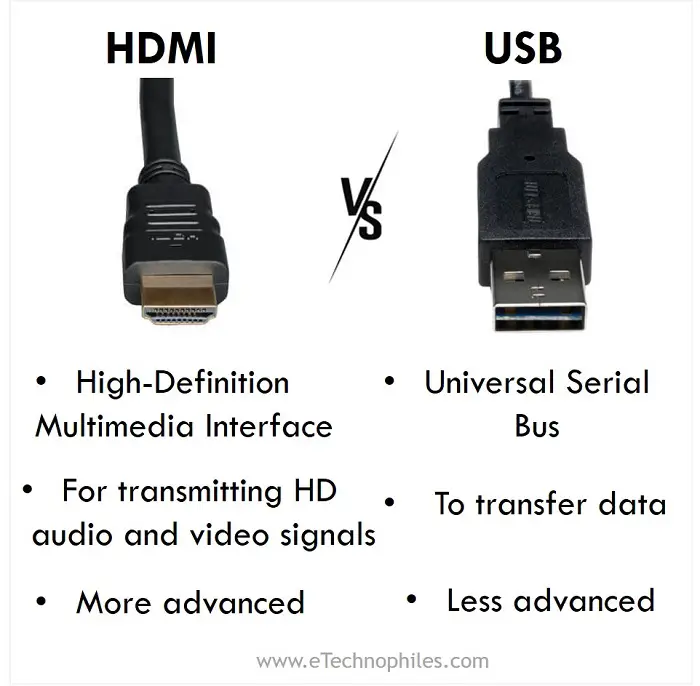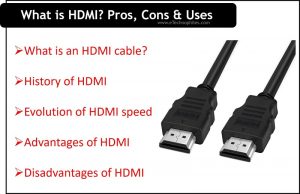Last updated on April 5th, 2024 at 12:37 pm
HDMI stands for High Definition Multimedia Interface. HDMI has become a popular choice for connecting devices such as TVs, DVD players, video game consoles, and projectors. High-definition quality is not the only reason for this product’s large acceptance into the market, but also its ability to transfer audio and video signals with a single cable.
This connectivity standard has thus almost replaced the previous standards such as DVI and component video that required separate cables for audio-video transmission.
Table of Contents
What is HDMI cable?

HDMI cable is primarily a digital replacement for the existing analog standards. It enables the transmission of enhanced, and high-definition audio-video signals across a single digital link. Since it transmits data without compression, it maintains the best transmission quality. This is the biggest advantage of the HDMI standard.
The HDMI connector resembles a larger version of the USB connector. It consists of 19 pins and thus 19 wires are assembled in a single HDMI cable. It can transmit eight different digital audio signals.
History
HDMI technology is a combined venture of Hitachi, Panasonic, Philips, Silicon Image, Sony, Thomson, and Toshiba. The major objective behind the development of HDMI was to create an AV connector that is backward-compatible with DVI.
The development of the first HDMI version started in early 2002, but its production started in late 2003. The HDMI provision was initially introduced to consumer HDTVs in 2004 and later to digital cameras in 2006. It became very popular by the year 2021. As per the records, nearly 10 billion HDMI devices were sold out in 2021.
Various improvements were made to the HDMI technology and connectors over time. The enhanced versions were introduced as HDMI 1.0, 1.2, and so on. The focus was to reduce the connector size and improve the data transmission capability.
Evolution of HDMI speed
Like other connector prototypes, HDMI has been upgraded over time. The major upgrade is the maximum pixel clock rate that enables faster data transmission.
HDMI 1.0 supports a maximum pixel clock rate of 165MHz. This allows the transmission of 1080 pixels at 60Hz. This was further improved to 340 MHz in HDMI 1.3 which allows the transmission of higher resolutions.
These advancements happened till the HDMI 2.1 version which is capable of supporting 8K resolutions and beyond. The newer versions also support features such as 3D, Consumer Electronics Control (CEC) extensions, Ethernet connection, etc.
What is the difference between HDMI and USB?

The HDMI and USB interfaces are often interchanged or confused with one another. The latest version of the HDMI connector is very similar to the USB connector due to its small size. But both technologies have significant differences in performance as well as usage.
- HDMI stands for High-Definition Multimedia Interface while USB stands for Universal Serial Bus.
- HDMI is a highly advanced interfacing technology compared to USB. It is used for transmitting high-definition audio and video signals while USBs are used to transfer data within computers and peripheral devices.
- While HDMI transmits AV signals within HD devices, USBs allow the communication of peripheral devices (mouse, keyboard, printer, etc.) to the computer.
- Similar to USB technology, HDMI also has different connector types that vary in size and transmission capacity.
Advantages of HDMI
- Maintains the best transmission quality without compression
- Combines both video and audio into a single convenient cable, eliminating the need for separate cables.
- HDMI is compatible with HDCP (High-bandwidth Digital Content Protection), which is a system used to protect digital content from unauthorized copying.
- Backward compatible with DVI
- Available in different connector types and sizes
- Supports 3D, Ethernet connection, and other features
Disadvantages of HDMI
- HDMI cables are not as widely available as USB cables
- More expensive than other options such as DVI or VGA
- Not all devices have HDMI ports, so an adapter may be needed
- The maximum length of a cable is limited, which can be a problem in larger rooms or venues
- Not all audio and video formats are supported by HDMI, which can be a problem for compatibility with some devices.
Read also: All HDMI Connector Pinout Explained(A,B,C,D)
FAQs
Can a USB-C Port transmit HDMI signals to a Monitor?
Yes. The Alt mode in USB C is designed to transmit other protocols. This includes HDMI signals also. Thus USB C is also compatible with transmitting HDMI data.
Is there any distance limitation for HDMI signals?
Yes. The maximum transmission distance is different for different HDMI standards. Higher standards support transmission over longer distances.
Where are the HDMI ports on the back of the computer?
HDMI ports are usually located on the motherboard. In some devices, they are located on video cards. However, not all computers have an HDMI port. The older models might have Display Ports or DVI ports instead of HDMI.
How can I improve the distance of the HDMI signal?
The latest versions of HDMI support longer distances. However, HDMI switchers and repeaters can be used to improve the transmission distance of the existing HDMI ports.
